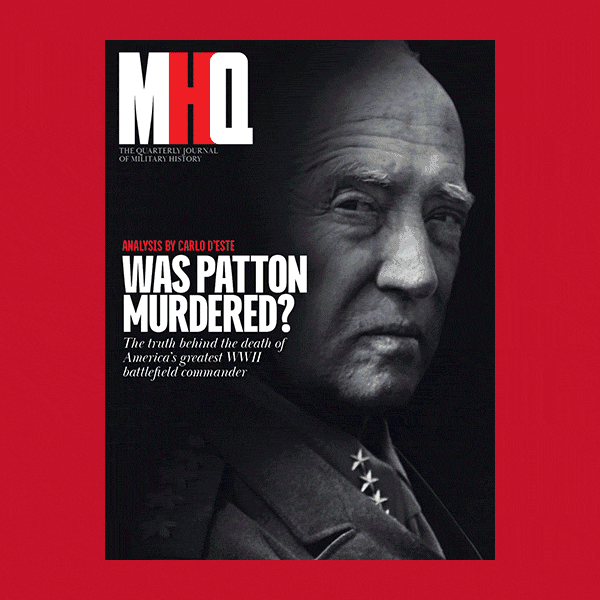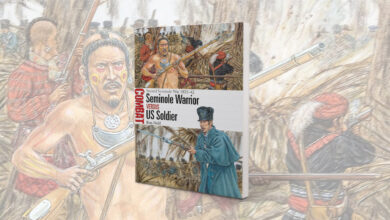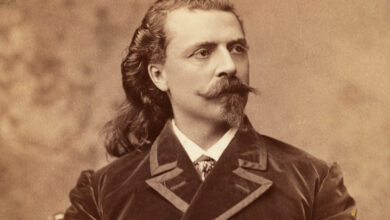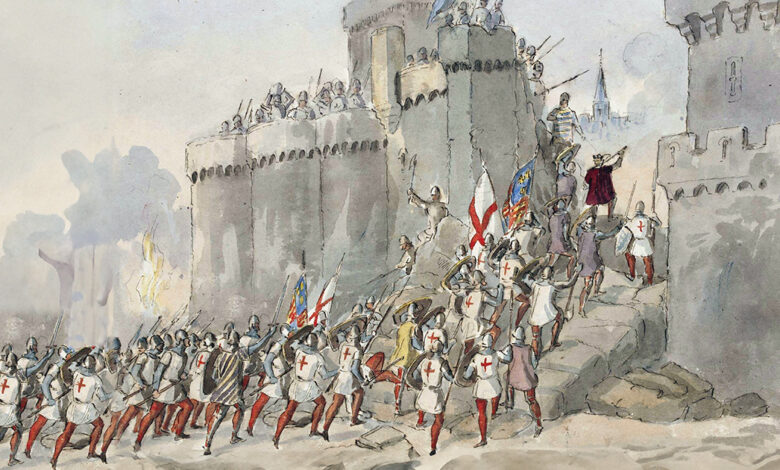
[ad_1]
Even though it officially lasted 116 years, the Hundred Years War was really just part of a long-running rivalry over land, power and inheritance between England and France that one may say, allowing for interruptions, raged from the Norman invasion of 1066 to Emperor Napoleon’s downfall in 1815. In the course of multiple reigns, the Hundred Years War was, as with its predecessors, replete with major and minor players, including such national heroes as England’s Henry V and France’s Maid of Orleans.
One of the war’s most intriguing characters, however, was not exactly heroic… but then again, he did not really exist. Or did he? At least in part?
Enter Shakespeare
In 1597 William Shakespeare published Henry IV Part 1, and with it introduced a corpulent, boastful knight who when not performing feats of extreme self-preservation on the battlefield, where he states “the better part of valor is discretion,” is carousing on borrowed or stolen money at the Boar’s Head Inn. Such is the perverse charisma of this “villainous, abominable misleader of youth” that he spends much of the play leading the young Prince Hal down a primrose path of self-indulgent dissolution. In the sequel, Henry IV Part 2, the old king dies and Hal assumes not only the throne but the responsibilities that it requires—and in so doing, puts aside “childish things,” starting with Sir John Falstaff.
Although Falstaff does not appear in Henry V, his death is mentioned, heralding an essential final step in the new king’s maturity. Such was the popularity of this outrageous but amiable reprobate, however, that one of Shakespeare’s most avid fans, Queen Elizabeth I, allegedly (though not confirmed for certain) suggested that he turn him loose once more, this time in the realm of romantic farce, a request that the bard brought to the stage in 1602 as The Merry Wives of Windsor.
Although no knight of the Hundred Years War quite matched the girth or gall of Sir John Falstaff, the evolution of his name includes an intriguing element of reality. Initially, Shakespeare was going to name the character Sir John Oldcastle, who really existed as a leader of the Lollards, a proto-Protestant sect—and a friend of Prince Hal’s until even that proved insufficient to prevent his being burned at the stake on Dec. 14, 1417.
When one of Oldcastle’s descendants, Henry Brooke, 11th Earl Cobham, learned of Shakespeare’s latest play and its intended comic lead, he bitterly objected. Deciding, like his character, that “the better part of valor is discretion,” Shakespeare switched to another name from the era, only this time altering it somewhat—from Sir John Fastolf to Sir John Falstaff.
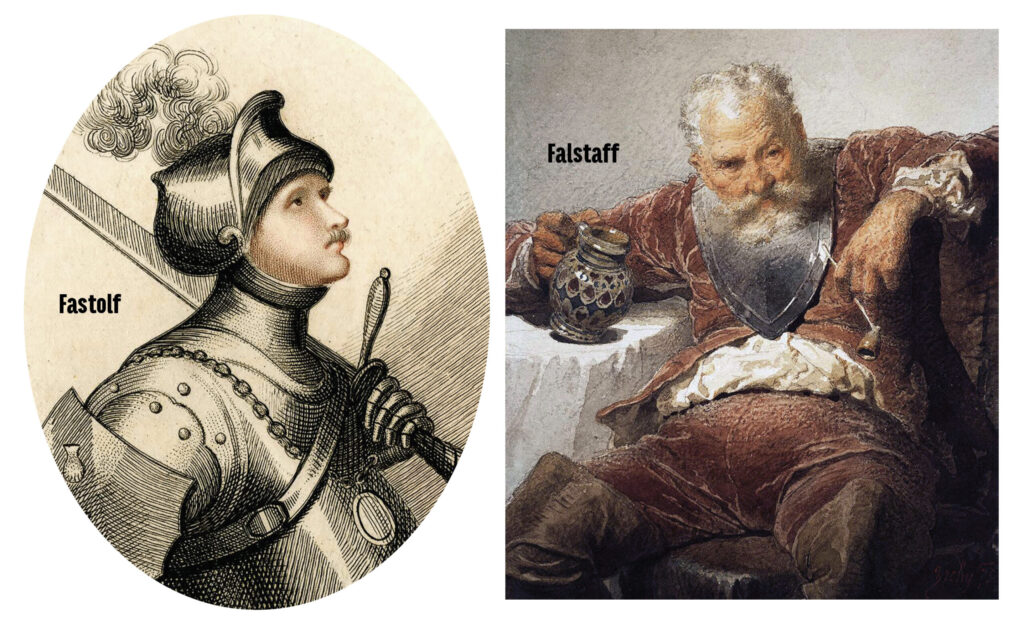
The rest was theatrical history… or was it? It turns out that Falstaff’s faux namesake had a cloud of disgrace hanging over his own head for more than a decade—and for Fastolf, it was no laughing matter.
The Real ‘Falstaff’
Sir John Fastolf was born on Nov. 6, 1380 in Caister Hall, Norfolk, to minor gentry. His father, also John Fastolf, died in 1383 and his mother, Mary Park, on May 2, 1406. Amid his education he claimed to have made a pilgrimage to Jerusalem in 1392-93, and also served as squire to Sir Thomas Mowbray, Duke of Norfolk. In 1401 he joined the retinue of King Henry IV’s second son, Thomas of Lancaster (later Duke of Clarence), with whom his first military duty was to keep the peace in the parts of Ireland ruled by the English. While there he met Millicent Tibetot, heiress of Robert, Lord Tiptoft, whose first husband, Sir Stephen Scrope, had died in 1408. At age 40, she was a dozen years Fastolf’s senior, but that did not stop their being wed on Jan. 13, 1409.
Whatever else Millicent had to offer, the marriage increased John’s assets five times over, with land holdings in Castle Combe and Bathampton in Wiltshire, Oxtenton in Gloucestershire and plots in Somerset and Yorkshire. He was entitled to 240 pounds per year, 100 of which he gave his wife but none to his stepson by her previous marriage, Stephen Scrope. John and Millicent had no children. To paraphrase The Taming of the Shrew, Fastolf had “wived it wealthfully,” a not uncommon factor in medieval weddings. In so doing, by funny coincidence, he handily achieved with one widow what his semi-namesake, Falstaff, failed to do with two in The Merry Wives of Windsor.
In 1415 Fastolf sailed to northern France to take part in King Henry V’s invasion, under the direct command of John of Lancaster, Duke of Bedford. A surviving warrant from the Exchequer dated June 18 noted payment due Fastolf and the 10 men-at-arms and 30 archers who came with him.
To Battle
On Aug. 18 he and his men were among the 2,300 men-at-arms and 9,000 archers under the Duke of Clarence, investing the Norman port of Harfleur. Although the ensuring siege featured a dozen large cannons—their first use by the English—Harfleur’s fortifications made it possible for a 100-man garrison under Jean, Sieur de’Estouteville to hold out long enough for 300 reinforcements to arrive under Raoul, Sieur de Gaucourt, who took charge of the defense.
The French stated that if their army did not come to their relief by Sept. 23, they would surrender. They capitulated a day earlier, leaving it to the paroled knights to collect their own ransom while townsfolk willing to swear fealty to King Henry were allowed to return home and others were ordered to depart.
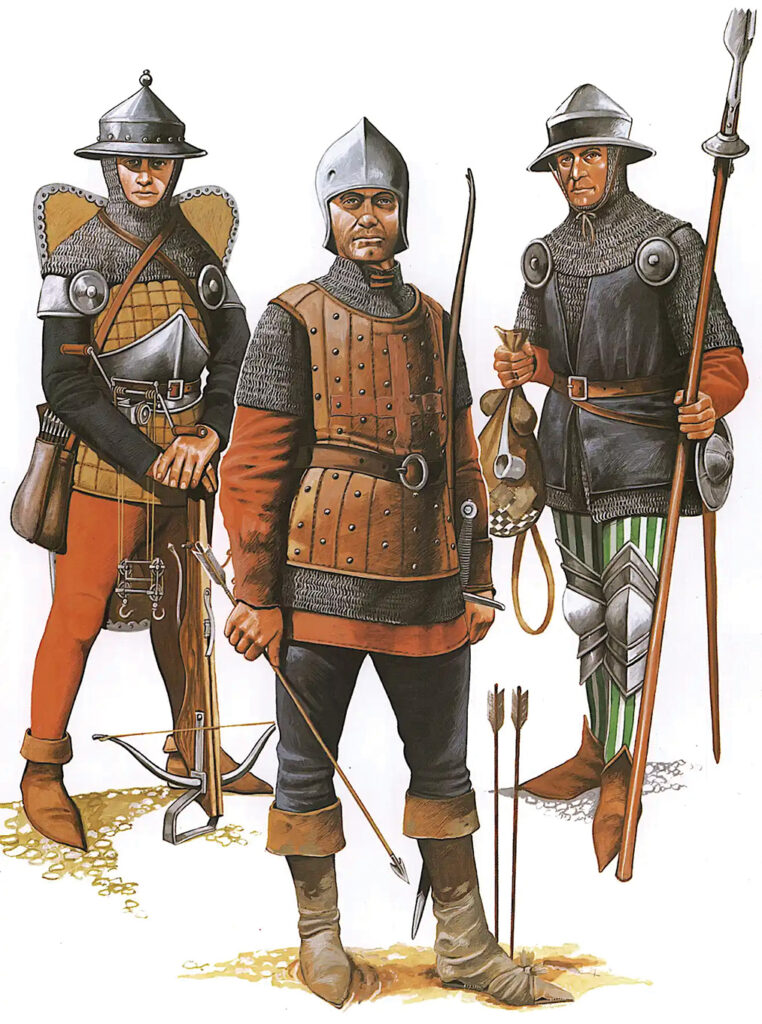
(Christopher Rothero, from MAA 113, The Armies of Agincourt by Christopher Rothero/Osprey Publishing, Bloomsbury Press Publishing)
The heaviest losses in the Siege of Harfleur were due to dysentery rather than combat. Many of Henry’s 5,000 casualties fell victim to the “bloody flux,” with at least 39 dead and 1,330 sent back to England to convalesce. Among its victims was Fastolf, who consequently was absent from the “band of brothers” who slaughtered the French at Agincourt on Oct. 25. He returned to Harfleur that winter, however, to help fend off a French attempt to retake the town.
Fastolf’s fortunes rose significantly thereafter, when he was formally dubbed a knight in January 1416. In 1420 King Henry compelled the French to sign the Treaty of Troyes, naming him regent to King Charles VI, a deal sealed by his marriage to the king’s daughter, Catherine, while the king’s son, the dauphin Charles, was disinherited. In the wake of this event, Fastolf was made Master of the Household to the Duke of Bedford, governor of Maine and Anjou, and when the English occupied Paris in 1421, he was appointed “governor” of the Bastille.
Scotland had entered the conflict on France’s side in 1419, and on March 22, 1421, the French, bolstered by the Army of Scotland, won a major victory at Baugé, in which the Duke of Clarence was killed. Worse for the English, Henry V died of a sudden bout of illness on Aug. 31 that same year. That left the English crown sitting unsteadily on the 9-year-old head of Henry VI, with the Duke of Bedford serving as his regent. On Oct. 21, 1422, King Charles VI died and Dauphin Charles set out to regain his throne. The Hundred Years War resumed.
The Battle of the Herrings
Fastolf was in Bedford’s army at the Battle of Verneuil-sur-Avre on Aug. 17, 1424, in which the again-outnumbered English turned the tables on the French, Scots and Milanese mercenaries after a climactic 45-minute struggle on foot. For the loss of 1,600 Englishmen, 6,000 of the enemy were killed. Most of the dead were Scots, for whom the English declared no quarter, including John Stewart, Duke of Buchan, Archibald, Earl of Douglas, and Sir Alexander Buchanan, the last of whom had been credited with slaying Clarence at Baugé.
The 200 French nobles taken prisoner and then ransomed included Jean II, duc d’Alençon and Gilbert Motier, Maréchal de La Fayette. Touted at the time as a second Agincourt, Verneuil crippled the Army of Scotland for the rest of the war. On Feb. 5, 1426, Fastolf’s cumulative battlefield exploits reached an apex when he was made a Knight Companion of the Most Noble Order of the Garter. A few years later, however, the veteran knight faced an unlikely nemesis in his most controversial battle.
On Oct. 12, 1428, the English invested the city of Orléans, opening more than six months of siege punctuated by numerous sallies, battles and supply attempts. One of the more prominent examples of the latter involved a convoy of 300 carts and wagons, carrying crossbow shafts, cannons, cannonballs and barrels of herring for the coming Lenten holiday. These departed Paris with a 1,600-man escort commanded by Fastolf. At the same time, Charles de Bourbon, comte de Clermont was leading a Franco-Scottish force he’d assembled to relieve Orléans while the commander of the city’s defenders, Jean de Dunois, led a force out to intercept the English convoy.
On Feb. 12, 1429, the two French forces met, totaling 4,000 men, and fell upon the convoy in a wide field at Rouvray-Sainte-Croix, about 10 miles north of Orléans. Fastolf ordered the wagons into a circular defensive laager. Clermont responded by deploying his cannons, which began inflicting casualties. At that point, the Scots’ leader, John Stewart of Darnley, ran too quickly out of patience and led a cavalry charge on the laager that forced the startled French to hold their fire rather than cannonade their allies. While the main French force hesitated, English bowmen rained arrows and crossbow bolts on the Scots. Then Fastolf unleashed his own cavalry, which overwhelmed the Scots, then lapped around the French flanks and rear, and drove them off in a disorganized rout. Darnley was among the 500 to 600 dead and Dunois was wounded.
Joan of Arc
Because of the special provisions Fastolf had been defending, his victory entered the history books as the Battle of the Herrings. On that same day, however, a teenage girl was trying to convince Robert de Baudricourt, the Dauphinois captain of Vaucouleurs, to let her confer with the Dauphin so that she could carry out her divinely ordained mission of saving France. She informed Baudricourt that the Dauphinois forces had just suffered a stinging defeat near Orléans, and that more would follow unless she was granted an audience with the Dauphin. Shortly after that, word arrived about the debacle at Rouvray and Baudricourt arranged the meeting that led to Joan of Arc taking a place alongside the hardened warriors defending Orléans—and contributing to the lifting of the siege on May 8, 1429.
Whatever direct role she had in raising the siege of Orléans, “la Pucelle” (the maid) indisputably elevated French morale. As the English forces withdrew to garrisons in the Loire River region, the veteran knights surrounding her were keen to make the most of it while they could. Jean II, duc d’Alençon, ransomed from English captivity, set his eyes on the Loire bridges. On June 12, French forces stormed Jargeau and captured the bridge at Meung-sur-Loire.
On the 15th they besieged Beaugency. Fastolf left Paris with reinforcements, which reached Meung to join forces with some of Orléans’ besiegers, led by John, 1st Earl of Talbot, and Thomas, 7th Baron Scales. With a total of 3,100 men at their disposal on June 18, Talbot urged an immediate attack on the French at Beaugency, but Fastolf recommended more caution in the face of a much larger enemy army. The defenders were unaware of the relief force’s proximity, but learned that a Breton contingent under Arthur de Richemont had just joined the French besiegers. The discouraged garrison surrendered.
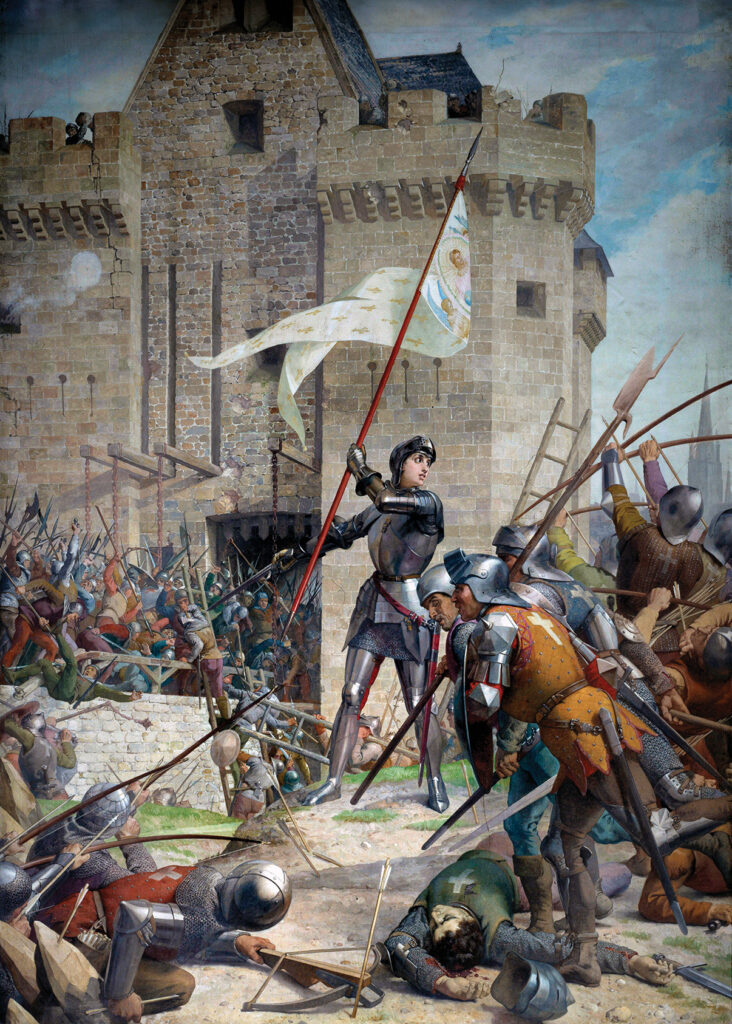
(Josse/Leemage/Getty Images)
Learning of Beaugency’s capitulation, Talbot agreed with Fastolf’s proposal that they withdraw to Paris. The French knew of the English presence, however, and being of no mind to call it a day, hastened off in pursuit, headed by a 180-knight vanguard under Etienne de Vignolles, nicknamed “La Hire” (the wrath), one of the first to accept Joan’s claims to divine inspiration. Close at hand were Jean de Xaintrailles, Antoine de Chabannes, Hugh Kennedy of Ardstinshar at the head of 800 Scots and the Maid herself. They caught up with their quarry near the village of Patay.
Fastolf’s Retreat
Since most of his army were archers, Talbot tried to engage the French using roughly the same tactics that had succeeded at Crécy in 1346 and at Agincourt in 1415, with most of his bowmen lined up behind a row of sharpened stakes. He also ordered 500 of them to take up ambush positions in the woods along the road. As they made their preparations, however, a stag ventured out in the field and one of the bowmen, thinking the French were still far away, gave a hunting cry.
The French vanguard was, in fact, close enough to hear that indiscreet call and, worse for the English, their archers had not yet fully deployed. Sending couriers to report the situation to the rest of their men-at-arms but not waiting for them to arrive, La Hire, Xaintrailles, Chabannes, Kennedy and Joan led a head-on charge that crashed into the English positions and exposed their flanks. Soon after that, 1,300 more mounted French men-at-arms advanced along a ridge south of the action, then deployed behind the English rear. As they began their charge, Fastolf led his contingent to join up with the mounted men-at-arms in the English vanguard, only to see them already quitting the field in disorder. Misinterpreting an order, his own men began to scatter, at which point he saw no alternative but to join them in retreat.
The rest of the battle amounted to a mopping-up operation for the French horsemen against little organized resistance. In the worst English defeat since Baugé in 1421, an estimated 2,500 were killed or captured, while the French only lost 100 (20 of whom were Scottish). The captured nobility included Talbot, Scales and Sir Thomas Rempston II, with only one knight of note escaping the debacle: Fastolf. Patay went down in history as Joan of Arc’s first victory in open battle. It also heralded a general French resurgence that led to the dauphin’s coronation as King Charles VII of France at Reims on July 17. For Sir John Fastolf, the engagement held different consequences.
Cowardice?
In 1431 another of Joan of Arc’s retinue, Jean Paton de Xaintrailles, was taken prisoner by Richard Beauchamp 13th Earl of Warwick, in a minor skirmish at Savignies. In 1433 a prisoner exchange returned Poton and Talbot to their respective armies. No sooner did Talbot return than he accused Fastolf of deserting him on the field at Patay. Fastolf, of course, hotly denied the charge, but by that time the Plantagenet aristocracy was starting to choose sides in regard to Henry VI’s fitness for the throne and as to who should succeed him.

(Wirestock/Getty Images)
Though nobody knew it at the time, the Hundred Years’ War for France was winding down and as the English soil was being furrowed for the War of the Roses, Fastolf found his protestations accepted by friends, such as Richard, 3rd Duke of York, and disbelieved by political enemies such as William de la Pole, 1st Earl of Suffolk. In between the Duke of Bedford accepted Talbot’s version of the battle but forgave Fastolf and continued to trust him.
The Order of the Garter conducted an enquiry on Fastolf and concluded that he had done his best at Patay, showing prudence rather than cowardice. Yet Suffolk and others persisted in questioning his honor and Fastolf spent over a decade defending himself. Such is the closest parallel history can find between Fastolf the tarnished warlord and Falstaff, Shakespeare’s unapologetic slacker.
Fastolf lost a friend when Bedford died in 1435. He himself retired from military service in 1440. He lost a powerful enemy a decade later when the Earl of Suffolk was condemned in Parliament for maladministration and banished from England for five years, only to be intercepted in the Channel by his own enemies while enroute to Calais and beheaded on May 2, 1450. Fastolf himself subsequently was almost convicted of treason for his association with the Duke of York, who would later make a direct bid for the Crown.
Where Fact Meets Fiction
While hostility grew within the Plantagenet family, England’s century-old effort in France officially ended when Talbot was defeated and killed at Castillon-sur-Dordogne, July 17, 1453. Less than two years later the eruption of hostilities at St. Albans on May 22, 1455, launched what amounted to civil war as the royal houses of Lancaster and York fell upon each other.
By then Fastolf’s ambitions were limited to keeping and administering his land holdings, which may explain his death on Nov. 5, 1459, at the exceptional old age of 78. His neighbor and close friend, John Paston, wrote the most detailed account of Fastolf, describing him in his last years as “an irascible, acquisitive old man, ruthless in his business dealings.” Buried at Saint Benet’s Abbey in the Broads, Norfolk, he bequeathed some of his possessions toward pious works, such as New Magdelen College at University of Oxford, but most went to Paston.
A unique aspect of Henry VI Part 1 is the appearance of both the real Fastolf and the fictional Falstaff—neither flattering. Despite the Order of the Garter’s decree, Shakespeare’s Fastolf appears as a cowardly antithesis to Talbot’s sometimes reckless bravery, deserting his comrade-in-arms not only at Patay, but at Rouen. The fictional Falstaff takes over from there for more serious frivolity.
Another intriguing coincidence lies in the place where Prince Hal, Falstaff and their retinue of ne’er-do-wells spend their mostly leisure time. Among the properties that John Fastolf is said to have owned as part-time proprietor was a tavern in Southwark, London called the Boar’s Head Inn.
[ad_2]
Source link

